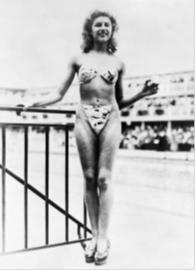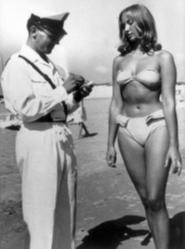 Louis Réard revolutionised women's fashion when he introduced, in July 1946, in the body of dancer Micheline Bernardine, “the smallest bathing suit in the world”, an episode reported by the New York Times as “Atomic Bomb”. From this time, it was only necessary to give a name to the new model, which broke with all the rules. A task that put the media in charge, that recalled a nuclear test that had happened months before in the atoll of Bikini and attributed the same name to the creation of Réard. Therefore Biquíni was born, causing several scandals because it revealed the feminine body, reflecting in the first sales like something without apparent success. The Vatican spoke up and considered this invention a crime. As a consequence, it was prohibited to sell in Spain and Italy and, in most states of the United States of America.
Louis Réard revolutionised women's fashion when he introduced, in July 1946, in the body of dancer Micheline Bernardine, “the smallest bathing suit in the world”, an episode reported by the New York Times as “Atomic Bomb”. From this time, it was only necessary to give a name to the new model, which broke with all the rules. A task that put the media in charge, that recalled a nuclear test that had happened months before in the atoll of Bikini and attributed the same name to the creation of Réard. Therefore Biquíni was born, causing several scandals because it revealed the feminine body, reflecting in the first sales like something without apparent success. The Vatican spoke up and considered this invention a crime. As a consequence, it was prohibited to sell in Spain and Italy and, in most states of the United States of America.
 In Portugal the bikini was also not well regarded. The rules instituted by Estado Novo included signs posted on the entrance of beaches with the regulations, but control did not end there. There were several maritime police that circulated on the beach to ensure the decency of women and find those who risked not complying.
In Portugal the bikini was also not well regarded. The rules instituted by Estado Novo included signs posted on the entrance of beaches with the regulations, but control did not end there. There were several maritime police that circulated on the beach to ensure the decency of women and find those who risked not complying.
The two pieces began to gain popularity when actresses like Brigitte Bardot and Marilyn Monroe, began to show their bikinis and to pose to the media, with an uncovered navel.
However, it was with Ursula Andress that the great explosion of this tendency occurred in the film Dr. from the 007 series. The actress came out of the water in a white bikini. The boom of bikini came to prove that its creator was right, because at the end of 70 years of his creation, the 194 centimetres of cloth were an atomic bomb all over the world, in the newspapers, beaches and customs.
 On the other side of the world, in Muslim culture, an opposite struggle is made with the ostentation and creation of the Burkini, seen as a symbol of the women emancipation. Yet the Burkini is regarded, in Western culture, as a symbol of the continuous women submission. The creator Aheda Zanetti said that “Burkini is a symbol of inclusion”. A culture that invokes the female figure as a symbol of sin and therefore, in addition to hiding the body, women are annulled from the active life of society, from political participation, professional life and to the access to education. The Burkini, which has been described as an achievement for Muslim women, is the continuation of women's subjection to discriminatory rules.
On the other side of the world, in Muslim culture, an opposite struggle is made with the ostentation and creation of the Burkini, seen as a symbol of the women emancipation. Yet the Burkini is regarded, in Western culture, as a symbol of the continuous women submission. The creator Aheda Zanetti said that “Burkini is a symbol of inclusion”. A culture that invokes the female figure as a symbol of sin and therefore, in addition to hiding the body, women are annulled from the active life of society, from political participation, professional life and to the access to education. The Burkini, which has been described as an achievement for Muslim women, is the continuation of women's subjection to discriminatory rules.




